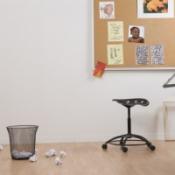
Editor’s note: This article is the 17th in an A-Z series on issues related to creative blocks. This month we explore how focusing too much on quality can hinder creativity.
Those of us who do creative work can, at times, become stuck during the creative process. One reason for this is that we tend to overemphasize the importance of the quality of the end result: we focus too much on how things will look in the end or on whether our idea will be perceived to be any good. Becoming constrained by our worries about degrees of creative excellence, instead of letting our minds wander freely, limits creative risk-taking and can contribute to developing nagging creative blocks. we may end up becoming creatively blocked.
Of course, quality is something that creative people ought to think about. A frequently referenced definition of creativity uses novelty and usefulness—or else quality—as its criteria for something to be considered creative. Creators generally need the reassurance that they’re judging their work with high standards. Yet there is a right and wrong time to be preoccupied with quality. If we become fixated with quality too early, this can be counterproductive and lead us to become creatively blocked. For an example of this, consider Stephen’s case below.
Stephen was a choreographer who had been feeling creatively blocked for about a year. He struggled to come up with ideas that fascinated or inspired him. During our work together, we spent some time exploring his self-critical tendencies and the way his depression was affecting his motivation to collaborate and try different ways to stimulate his brain. While all this was helpful, it didn’t seem to hit the nail on the head regarding what was sustaining his creative block.
Taking a break from emphasizing the quality of our creative results is not easy. We want to feel that our time is well-spent in coming up with ideas that will make the cut and be certain these ideas will be part of the final product.
Part of our work included keeping a “process journal.” I encouraged Stephen to keep track of all the thoughts he had that pertained to the process of starting to choreograph. One of the things we discovered was that he would evaluate the quality of every idea as soon as he had that idea. Every thought about what kind of music to use turned into a question of whether the end result would be “edgy’ or “experimental” enough. Every thought about unique ways to use his body turned into an assessment of whether the movement would look pretty. Overall, every creative spark was quickly snuffed out by concerns about whether the choreography would result in his best work yet.
Stephen and I quickly noticed the negative effect this habit had on his ability to think creatively. To tackle this concern, we made deliberate attempts to embrace the messiness that is often involved during the creative process.
- We affirmed the value of making an effort, regardless of the outcome.
- We established a consistent choreography schedule so he’d know that even if one practice session went poorly, he had another planned shortly after.
- He avoided recording his choreography ideas until he felt more confident to watch videos of himself trying them out.
- He looked for sources of inspiration among other choreographers, both those who were well-established and those who were just beginning.
In addition to learning how to tolerate the unpredictability of creative efforts, Stephen also eventually learned to catch his internal voice when it asked questions like “Is this any good?” and “How does this look?” Though change didn’t happen overnight, he practiced listening to a different voice—one that said “This is new and interesting!” and “I’ve always wanted to try this. Here’s my chance!”
Taking a break from emphasizing the quality of our creative results is not easy. We want to feel that our time is well-spent in coming up with ideas that will make the cut and be certain these ideas will be part of the final product. However, a rigid attitude on what “time well-spent” means can only limit our brains’ natural abilities to make new cognitive associations and come up with innovative ideas and solutions.
If you struggle to do this on your own, consider seeking support from a qualified, compassionate mental health care professional.
© Copyright 2017 GoodTherapy.org. All rights reserved. Permission to publish granted by Olga Gonithellis, MA, MEd, LMHC, Creative Blocks Topic Expert Contributor
The preceding article was solely written by the author named above. Any views and opinions expressed are not necessarily shared by GoodTherapy.org. Questions or concerns about the preceding article can be directed to the author or posted as a comment below.

 Creative Blocks from A to Z: Perfectionism
Creative Blocks from A to Z: Perfectionism Creative Blocks from A to Z: Openness to Experience
Creative Blocks from A to Z: Openness to Experience Creative Blocks from A to Z: Negative Thinking
Creative Blocks from A to Z: Negative Thinking